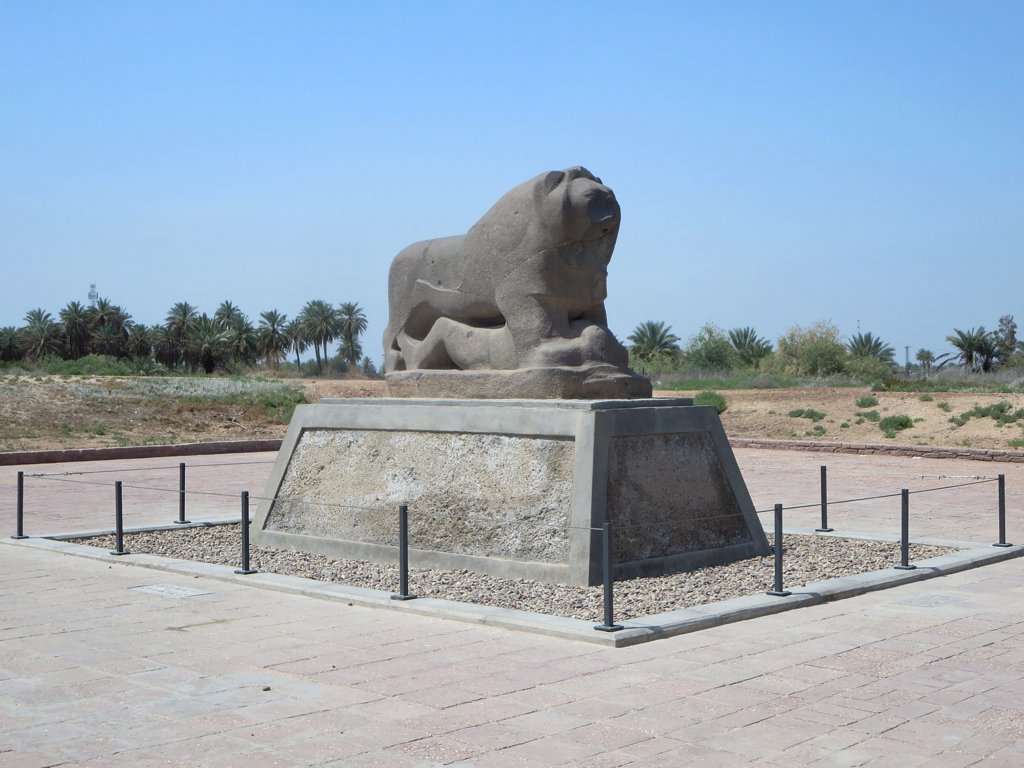Lion of Babylon (statue) on:
[Wikipedia]
[Google]
[Amazon]


 Lion of Babylon is a stone sculpture, over 2600 years old, that was found in the ancient city of Babylon, Iraq. It was discovered in 1876 by a German archaeological mission.
The statue may have been commissioned by the Chaldean Babylonian king Nebuchadnezzar II (605–562 BC), but most experts now belief it is of Hittite origin, made during a Hittite occupation of the city.
Lion of Babylon is a stone sculpture, over 2600 years old, that was found in the ancient city of Babylon, Iraq. It was discovered in 1876 by a German archaeological mission.
The statue may have been commissioned by the Chaldean Babylonian king Nebuchadnezzar II (605–562 BC), but most experts now belief it is of Hittite origin, made during a Hittite occupation of the city.


 Lion of Babylon is a stone sculpture, over 2600 years old, that was found in the ancient city of Babylon, Iraq. It was discovered in 1876 by a German archaeological mission.
The statue may have been commissioned by the Chaldean Babylonian king Nebuchadnezzar II (605–562 BC), but most experts now belief it is of Hittite origin, made during a Hittite occupation of the city.
Lion of Babylon is a stone sculpture, over 2600 years old, that was found in the ancient city of Babylon, Iraq. It was discovered in 1876 by a German archaeological mission.
The statue may have been commissioned by the Chaldean Babylonian king Nebuchadnezzar II (605–562 BC), but most experts now belief it is of Hittite origin, made during a Hittite occupation of the city.
Description
The statue is made out of black basalt; it depicts aMesopotamian lion
The Asiatic lion is a population of ''Panthera leo leo'' that today survives in the wild only in India. Since the turn of the 20th century, its range has been restricted to Gir National Park and the surrounding areas in the Indian state of Gujarat ...
standing above a lying human. The statue is two meters in length and the platform upon which it stands is one meter high. The lion weighs about 7000 kg. The statue's height is 1 meter.
On the back of the lion is a carved depression, in which it is believed that a saddle was originally placed, on which a figure of Ishtar
Inanna, also sux, 𒀭𒊩𒌆𒀭𒈾, nin-an-na, label=none is an ancient Mesopotamian goddess of love, war, and fertility. She is also associated with beauty, sex, divine justice, and political power. She was originally worshiped in Su ...
, the goddess of fertility, love, and war, may have sat or stood.
Modern history
The statue had been damaged over the years due to lack of protection, getting climbed on by tourists that left marks on the statue, or natural causes like erosion which Archaeologists had already feared was going to happen without the right protection of the statue. However, the most significant damage, as seen today, to the face and jaw was caused in 1917, as witnessed by Private Robert John Morgan of the Army Service Corps duringWorld War I
World War I (28 July 1914 11 November 1918), often abbreviated as WWI, was one of the deadliest global conflicts in history. Belligerents included much of Europe, the Russian Empire, the United States, and the Ottoman Empire, with fightin ...
.
In 2013 the World Monuments Fund
World Monuments Fund (WMF) is a private, international, non-profit organization dedicated to the preservation of historic architecture and cultural heritage sites around the world through fieldwork, advocacy, grantmaking, education, and trainin ...
worked with the Iraq State Board of Antiquities to make improvements to the site. The Lion was cleaned and partially restored, the base of the statue was replaced, and a security barrier was added.
Symbolism
TheLion of Babylon
The Lion of Babylon is an ancient Babylonian symbol.
History
Antiquity
The Lion of Babylon symbolically represented the King of Babylon.Benjamin Sass, Joachim Marzahn. Aramaic and figural stamp impressions on bricks of the sixth century B. ...
is a historic theme in the region. The statue is considered among the most important symbols of Babylon in particular and Mesopotamian art in general. The statue is considered a national symbol of Iraq, it has been used by several Iraqi institutions such as the Iraqi Football Association
The Iraq Football Association (IFA) ( ar, الاتحاد العراقي لكرة القدم) is the governing body of football in Iraq, controlling the Iraqi national team and the Iraqi Premier League. The Iraqi Football Association was founded ...
.
The lion was meant to put fear into their enemies, by showing a lion trampling a man to scare their enemies.
See also
*Ishtar Gate
The Ishtar Gate was the eighth gate to the inner city of Babylon (in the area of present-day Hillah, Babil Governorate, Iraq). It was constructed circa 575 BCE by order of King Nebuchadnezzar II on the north side of the city. It was pa ...
* ''Lion Hunt of Ashurbanipal
The royal Lion Hunt of Ashurbanipal is shown on a famous group of Assyrian palace reliefs from the North Palace of Nineveh that are now displayed in room 10a of the British Museum. They are widely regarded as "the supreme masterpieces of Assyria ...
''
* Lion of Basrah
* Lion of Babylon
The Lion of Babylon is an ancient Babylonian symbol.
History
Antiquity
The Lion of Babylon symbolically represented the King of Babylon.Benjamin Sass, Joachim Marzahn. Aramaic and figural stamp impressions on bricks of the sixth century B. ...
* Lion of Judah
The Lion of Judah ( he, אריה יהודה, ) is a Jewish national and cultural symbol, traditionally regarded as the symbol of the tribe of Judah. The association between the Judahites and the lion can first be found in the blessing given b ...
References
{{Reflist Archaeological discoveries in Iraq Babylonian art and architecture Hittite art National symbols of Iraq Nebuchadnezzar II Sculptures of lions Sculpture of the Ancient Near East